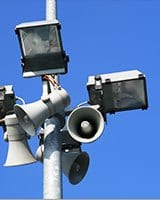Your Emergency Communications Plan can fall short if it doesn’t include POWER
 In an emergency, communication is critical and can be the difference between a safe exit and a headline-grabbing disaster. Building an overall fault-proof system can be an overwhelming task, power included. What are some common questions when setting up power protection for emergency communications?
In an emergency, communication is critical and can be the difference between a safe exit and a headline-grabbing disaster. Building an overall fault-proof system can be an overwhelming task, power included. What are some common questions when setting up power protection for emergency communications?
– How can we be 100% sure mass notifications will go out?
– What government regulations exist for emergency communications backup?
– Should a specific type of UPS be used? How much-extended runtime do we need? Read on to find out.
The importance of Communication

Businesses and campuses must be able to communicate with everyone in a facility, and the larger the campus, the more urgent the need for a comprehensive emergency communications plan.
All educational institutions must be able to communicate with students and faculty. Retail stores must communicate with employees and customers. Businesses must communicate with their employees. Without emergency communications and mass notification systems, people are further endangered and liability issues are magnified.

Ensuring Power Availability
All components within an emergency communications system depend on the availability of electricity in order to fully function. During any type of disaster, or even in a temporary power outage, it is absolutely essential that communications are not interrupted.
Uninterruptible Power Supplies

This can be accomplished with the installation of an uninterruptible power supply (UPS), which provides protection from all power problems such as surges and spikes, but also provides battery backup power during a power outage. Back-up power is a critical component of any emergency communications system. Learn more about UPSs in our Newbie’s Nook Series >>
Government Regulations
 In many states and localities, emergency communication systems require a 24-hour quiescent load capability, meaning that when the system is not being used, there are at least 24 hours of battery backup capacity should the power fail. Other mandated regulations may require a minimum of fifteen minutes of full-load alarm capacity from a UPS. These systems may also have to function for long periods of time during an emergency.
In many states and localities, emergency communication systems require a 24-hour quiescent load capability, meaning that when the system is not being used, there are at least 24 hours of battery backup capacity should the power fail. Other mandated regulations may require a minimum of fifteen minutes of full-load alarm capacity from a UPS. These systems may also have to function for long periods of time during an emergency.
Actual use time could range anywhere from 30-60 minutes, but typically only a partial load is required when an announcement is being made. The code requirements should be evaluated by a system designer to determine if a larger capacity or longer battery backup time should be provided or is required by the state, local, or federal regulations.







